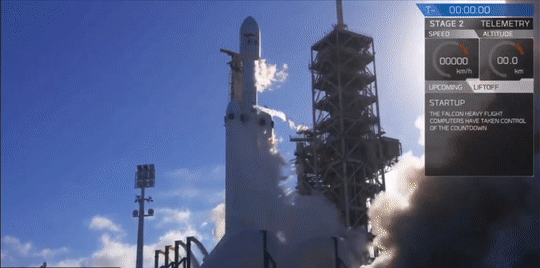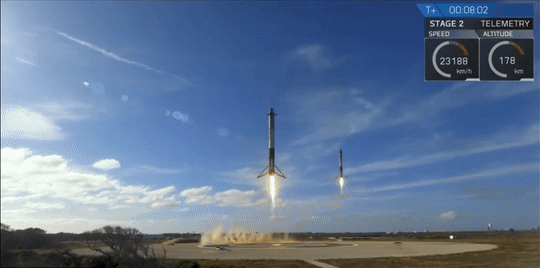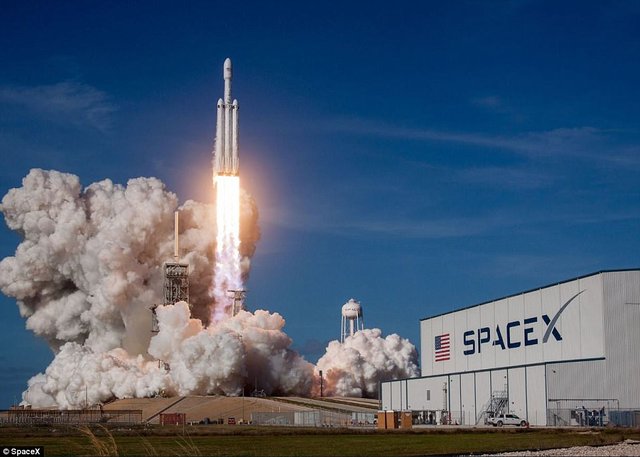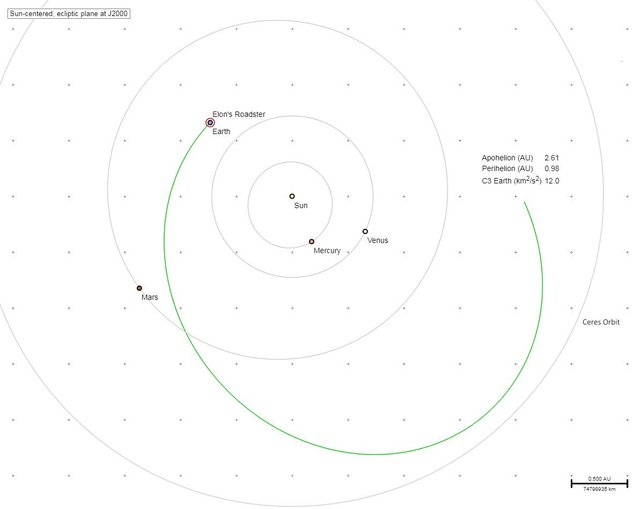Falcon Heavy launch - history in the making and dreams of space rekindled
Yesterday, the historic launch of SpaceX's newest launch vehicle, which I covered here, the mighty Falcon Heavy, launched from Launchpad 39A of Cape Canaveral in Florida. This is the moment customers, other launch operators, space companies and space enthusiasts have been waiting for since 2011, when it was first announced by SpaceX CEO, Elon Musk. It was originally slated to fly in late 2013, but rocket science isn't exactly as easily predicted as one would've hoped. This was mostly due to the fact that the core of the rocket, the Falcon 9, has been upgraded numerous times, that Falcon Heavy was pushed back in order to not waste resources adapting to a version that would later be discarded, thus redesigning it every time. Though, this was still the case in the end, as the center core is an adapted older version of the Falcon 9, whereas the side boosters were adapted versions of Falcon 9 Block 5 (or 1.2).
In any case, building the three-core rocket in not as easy as strapping 3 cores together, as the stress exerted in much greater for the skeleton of the beast, that being the center core, totaling to a maximum thrust at sea level of 22.8 million N. This is generated by a total of 27 Merlin M1-D, nine per core. Additionally, adding nose cones to the side boosters changes their aerodynamic profile, actually decreasing maneuverability when coming back to land. And considering reusability is the cornerstone of SpaceX, this had also cause major delays, leading to changing the gridfins, the small winglets at the top of the rocket that deploy on reentry, had to be redesigned from earlier models, no longer being flat, and built out of titanium rather than aluminium. Also, it was originally planned for the rocket to employ fuel crossfeed, so that the outer cores would pump fuel to all engines and the center core, so that it would have a longer burn time, but this idea was ultimately scrapped.
Now for some statistics. This rocket, now that it has flown, is the most powerful operational rocket by a factor of two, its nearest competitor being the Delta IV Heavy, and only being outmatched in this regard by the the mighty Saturn V, which hasn't flown in decades. It is 70 meters tall, 12.2 meters wide, with every core's diameter being 3.66 meters and weighs 1,420,788 kilograms on the pad. It's payload capacity ranges from 3.5 tonnes to Pluto, to 63.8 tonnes to LEO (Low Earth Orbit), if all cores are disposed of, obviously this decreases substantially if a landing is attempted.
Now, on to the actual launch, which you can watch above. At first, it seemed that yesterday's launch would be delayed again, as upper level winds seemed to be a tad too high velocity for a safe flight, especially since this is a test, one would want as best conditions as possible. But, with the launch window closing in rapidly, the giant beast took off, as you can see below this paragraph. It must've been amazing being there and witnessing history in the making. And to hear the roar of the engines must've been something else. If you have good headphones, and want to hear some proper sound from the launch, I recommend watching Smarter Every Day's video. Anyway, Elon Musk breathed a sigh of relief when the rocket rose to the skies, as he said in previous interviews that "if it clears the pad, I'll be happy".

After passing MaxQ (maximum dynamic pressure), during trans-sonic speeds when the rocket is under the most amount of stress, the boosters could throttle up to 100%, as they started at 92% at launch in order to not break the vehicle apart. Not long after that, at around the three minute mark, a series of milestones occurred, from BECO (booster engine cut-off), to booster separation, to MECO (main engine cut-off), to stage 1 separation, to the boostback burns of the side cores and stage 2 ignition and fairing jettison. The the SpaceX team's, and future customers' and space enthusiasts', delight, all of these events went on without a hitch. But after around seven minutes since lift-off, probably the most majestic and inspiring even was to occur, with the two side boosters landing back at LZ-1 (landing zone 1) and LZ-2 (landing zone 2) of the Cape Canaveral Space Center. If this does not inspire a new space race and inspire people across the world to get back to exploring space, then I don't know what will. Here's hoping the ambitious projects multiple governments and companies have engaged in lately, will fuel these adventures. By the way, if you wish to view uncut footage of the launch and landing of the side boosters, you can do so here, in a video captured by a visitor there (since on my live post of the launch, I got my first "skeptic" accusing this as CGI).

But alas, unfortunately, the center core, which was supposed to land on the drone ship Of Course I Still Love You in the Atlantic Ocean did not land safely and was lost. This was due to running out of ignitor fuel and only one engine relit for the landing burn, instead of three. Thus, not enough velocity was drained and the core splashed in the water at around 500 kilometers per hour and took out two engines from the barge as well. It is unclear yet if this also took out the cameras on board, but as Elon Musk mentioned in a press conference soon after, if they did survive, the blooper reel would be released in the future. You can watch this conference where he answered questions posed by media and fans in the video below.
In it, he talks the investment of probably more than half a billion dollars into the project. Other things he touched on were, the timeline for future projects and launches for the Falcon Heavy and plans for the future. Also, he mentioned that neither of the cores would be used again anyway, so the loss of the center core is not too damaging, especially since it was not the latest version (Block 5), and would've been retired after yesterday's test anyway.
But though the webcast of the launch ended after these events, the show did not really end. Sure the launch was done, but there was still work to do, and beautiful vistas to enjoy. So for people wanting bore, for a good few hours they could enjoy Starman sitting in the fastest car ever enjoying the views of the pale blue dot, our homeworld, Earth. The car did not remain in LEO (Low Earth Orbit), as the SpaceX team wanted it to stay within the Van Allen belts, where the radiation is intense, much more than a typical time a trip to Mars would linger there. This was probably to test Starman's spacesuit, which is the real deal, also developed by SpaceX for future astronauts to travel in the capsule they're still working on, the Dragon II, and other equipment, data that could be used in the future. Thus, during most of the six hours while the car's apogee (highest point of an orbit) was smack in those belts, at around 7,000 kilometers altitude above the planet, people could watch it live while it spinned in space, and now you can too, in the video below.
After this time was up, it was time to send it into interplanetary space, at around the same orbit as Mars, as Elon put it. So, the final burn of the second stage was to fuel depletion, and that ended up boosting further than Mars, up to around the Asteroid Belt between the red planet and Jupiter. You can see this orbit in the image to the right. Note: AU means astronomical unit, which is the distance between the Earth and the Sun, and is just under 150 million kilometers. The car then can be as far from Earth as 540 million kilometers away, and reached a maximum speed of 12 kilometers per second, and will remain in this Sun orbit for who knows how long, maybe it will even outlive humans and it ends up being picked up by some aliens.
Anyway, my final thoughts are this. I'm glad I managed to witness history being made, and I hope to some day get there in person. Although there was a small hiccup with the center core being lost, all other objectives were achieved, if not exceeded. SpaceX proved, once and for all, that it is a major force in the space world, and it can manage to cheapen access to space, which hopefully spurs others to build on top of this, and expand humanity's reach, if not to other stars yet, then at least to other planets within our solar system. I await the next SpaceX launch, but unfortunately it will be a while until I can see that synchronized landing again, which is just art, if you ask me. This test brings this mad genius, Elon Musk one step closer to his dream of dieing on Mars. Here's hoping that colony gets built some day, eh? Congratulations, SpaceX, to more successful launches and endeavors!
What are your opinions on what this launch means for the future of space travel and explorations? Did you watch it live? How long do you think proper competition arrives to challenge SpaceX's claim to the throne? Share your thoughts below, along with any feedback you might have. It is greatly appreciated!
Thank you for reading, and keep on steemin'!
(clicking any image will take you to its source)


Hi, I found some acronyms/abbreviations in this post. This is how they expand:
Disclaimer: I am just a bot trying to be helpful.
I couldn't have said it any better. Good review of the launch!
Thanks mate! Glad you enjoyed the read :)
Glad you shared! I learned so much from your interview on Whaleshares!
Thanks, and no problem, I often post space stuff! Glad I could share good information :)
Yeah it's definitely a game changer that they can recover parts.
They've been successfully recovering boosters of the Flacon 9 for around two years now, which drastically reduced costs. Now they're going bigger, but it is much harder. But this was a success, regardless. They sent the payload even further than planned (as they just burned off all the fuel in the second stage), and landed back 2 out of 3 boosters. And that footage of those two landing in sync was just ... orgasmic almost :p
looks like you are very interested in this kind of "games and toys" - rockets or so :D
Sure am. Space is just awesome!
PS: Racket inseamna stoarcere de bani prin violenta. Nu-s prea mare fan la asta, si nici politia n-ar fi :p
:))) pardon, abia mă trezisem când am lăsat comentariul. Am sa dau edit sa corectez :)
Nu-i nimic :)
Chiar daca-i un subiect serios, mai si glumim, nu?
Corect :)
Oh... chiar ma intrebam ce s-o intamplat cu "center core"-ul ca se luase camerele in timpul live-ului si pe urma am uitat sa mai caut info, desi aveam pe cine intreba - un vechi prieten de la care stiam de lansare si mi-am zis... ia sa ma uit si eu la ce se uita omul asta!
Multumesc!
Da, au anuntat in conferinta aia. Sper ca ti-a placut hobby-ul prietenului tau :)
Si nici o problema, ma bucur ca a fost de folos informatia.